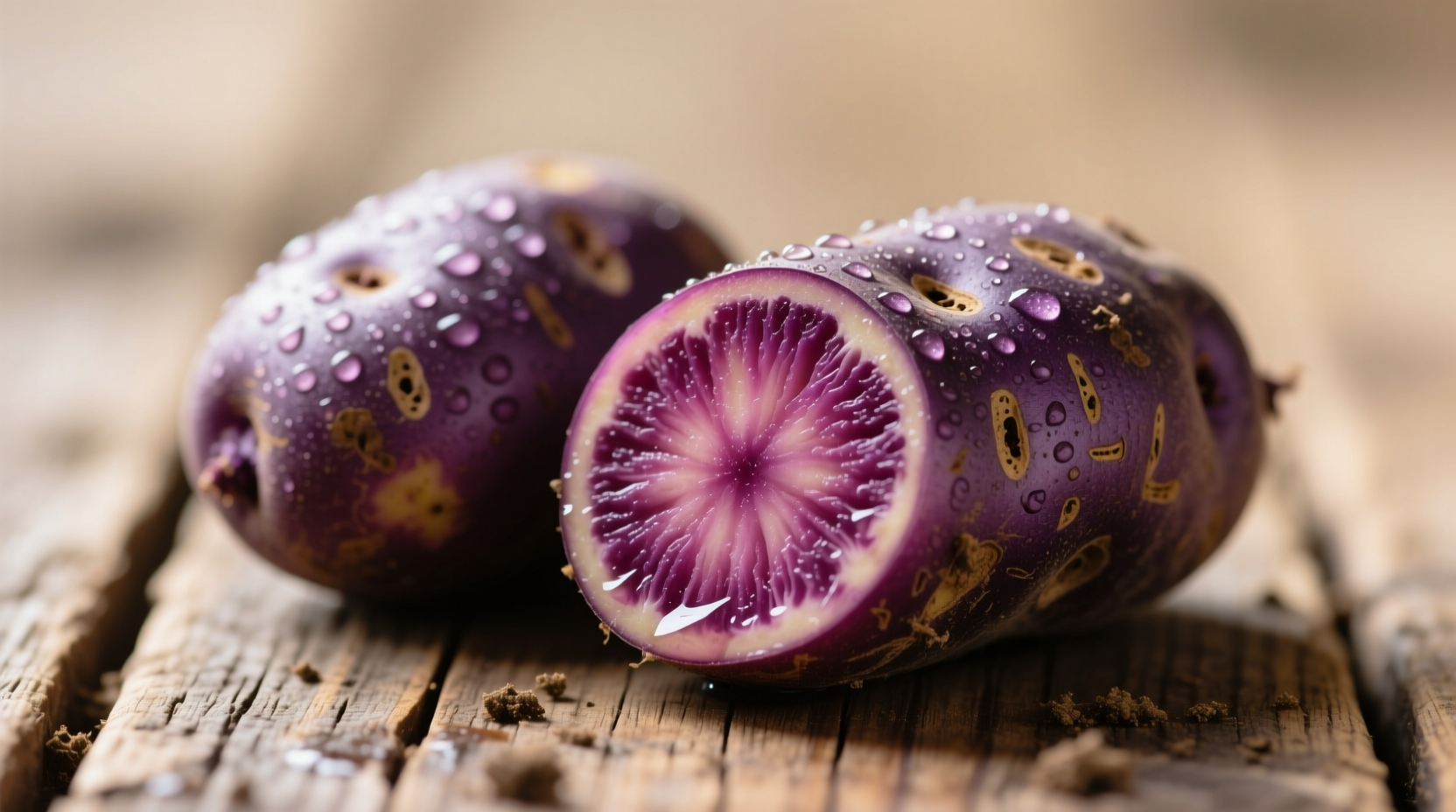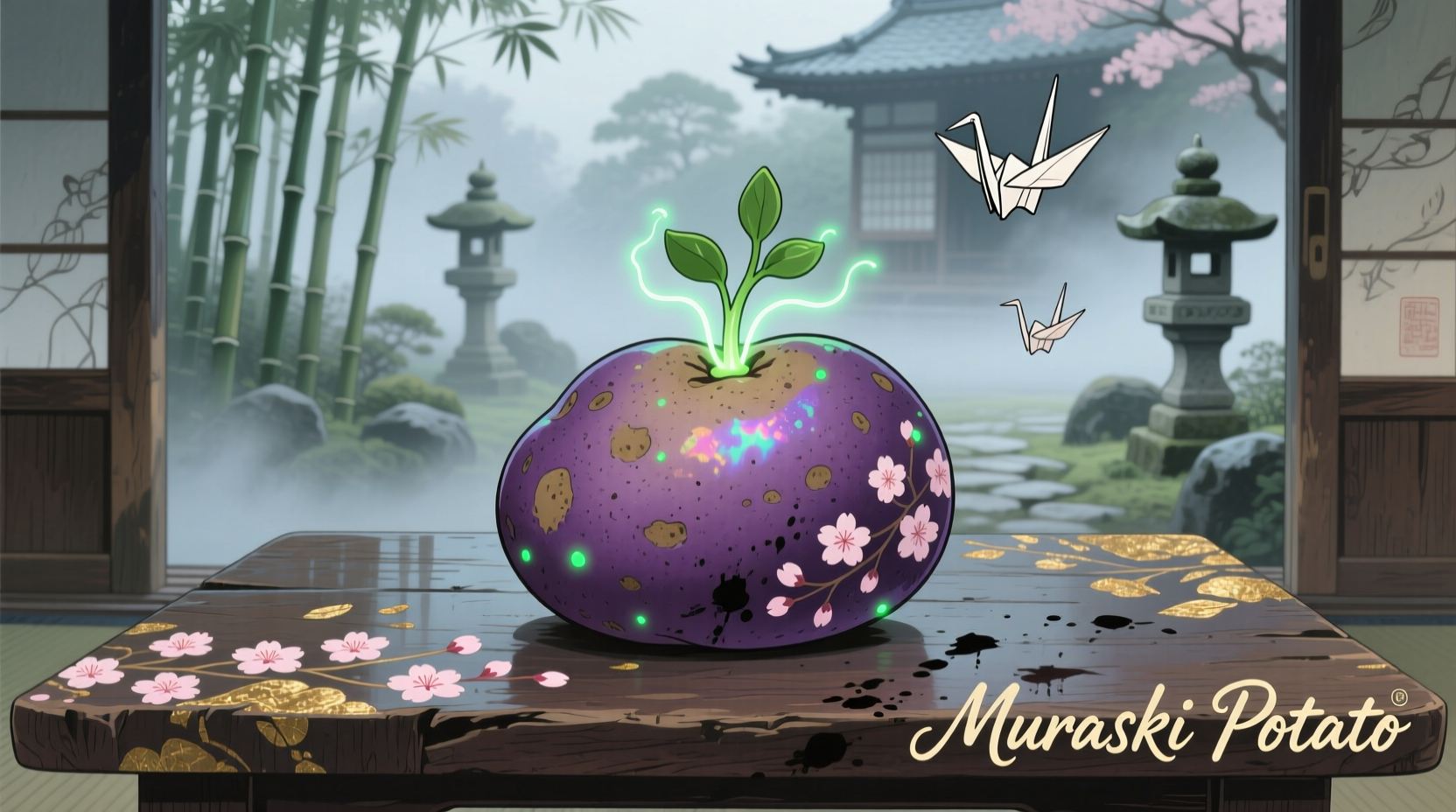When you bite into a murasaki potato, you're experiencing centuries of agricultural tradition combined with exceptional nutrition. These striking purple tubers—also known as Okinawan sweet potatoes—deliver three times more antioxidants than regular orange sweet potatoes while offering a subtly sweet, chestnut-like flavor perfect for both savory and sweet applications.
What Exactly Is a Murasaki Potato?
The murasaki potato (Ipomoea batatas), whose name means "purple" in Japanese, features deep purple skin and equally vibrant purple flesh. Unlike genetically modified purple potatoes, murasaki varieties developed naturally through traditional cultivation in Okinawa. These tubers contain exceptionally high levels of anthocyanins—the same antioxidants found in blueberries and blackberries—which give them their distinctive color and significant health benefits.
| Potato Variety | Flesh Color | Key Nutrients | Flavor Profile |
|---|---|---|---|
| Murasaki | Vibrant purple | Anthocyanins, Vitamin C, Fiber | Sweet, chestnut-like, less sugary |
| Beauregard (Orange) | Bright orange | Beta-carotene, Vitamin A | Very sweet, moist |
| Japanese (Satsumaimo) | White to pale yellow | Maltose, Potassium | Delicate sweetness, dry texture |
| Regular White Potato | Creamy white | Potassium, Vitamin C | Neutral, starchy |
Nutritional Powerhouse: Science-Backed Benefits
According to USDA FoodData Central, a single 130g murasaki potato provides 103 calories, 24g carbohydrates, 3.8g fiber, and delivers 35% of your daily vitamin C needs. What truly sets them apart is their anthocyanin content—studies published in the Journal of Agricultural and Food Chemistry confirm murasaki potatoes contain 1.5-2.5 times more anthocyanins than blueberries by weight.
These powerful antioxidants contribute to several health benefits:
- Reduced inflammation markers in clinical studies
- Improved cognitive function in aging populations
- Enhanced blood sugar regulation compared to regular potatoes
- Cardiovascular protection through improved endothelial function

Culinary Applications: From Traditional to Trendy
Murasaki potatoes shine in both traditional Japanese preparations and modern culinary innovations. Their lower sugar content compared to orange sweet potatoes makes them exceptionally versatile:
Traditional Okinawan Preparation
In Okinawa, locals typically steam murasaki potatoes whole for 25-30 minutes until tender. This simple method preserves their delicate flavor and maximizes nutrient retention. The traditional pairing with a sprinkle of sea salt enhances their natural sweetness without overpowering their subtle chestnut notes.
Modern Culinary Techniques
Chefs worldwide utilize murasaki potatoes for their visual appeal and nutritional profile:
- Roasting: Cut into wedges with olive oil and rosemary at 400°F for 35 minutes
- Mashing: Steam until tender, then mash with a touch of coconut milk for vibrant purple mash
- Baking: Substitute for regular sweet potatoes in pies (use 25% less sweetener)
- Raw applications: Spiralize for colorful salads or grate into slaw
Growing Murasaki Potatoes: What Home Gardeners Should Know
Unlike regular potatoes, murasaki varieties grow from slips (vine cuttings) rather than seed potatoes. They require 120-150 frost-free days and thrive in warm climates with well-draining soil. The University of Hawaii Agricultural Extension recommends planting slips 12-18 inches apart in raised beds with consistent moisture during the first 60 days of growth.
Harvest when leaves begin yellowing, typically in late summer. Cure harvested tubers at 85-95°F with 85-90% humidity for 5-10 days to develop their characteristic sweetness and improve storage life.
Where to Find and How to Select Murasaki Potatoes
While once difficult to find outside specialty markets, murasaki potatoes now appear in many mainstream grocery chains including Whole Foods, Trader Joe's, and select Kroger locations. Look for these selection tips:
- Firm tubers with smooth, unblemished purple skin
- Medium-sized potatoes (6-8 ounces) for optimal texture
- Avoid those with soft spots or green discoloration
- Check the stem end for freshness—should be dry, not moist
During peak season (August-November), farmers markets often carry locally grown varieties with superior flavor compared to imported options.
Proper Storage for Maximum Freshness
Unlike regular potatoes, murasaki varieties require specific storage conditions:
- Store at 55-60°F (13-16°C)—never refrigerate
- Keep in a dark, well-ventilated container (paper bag works well)
- Never store near onions, which release gases that accelerate spoilage
- Use within 3-5 weeks for best quality
For longer preservation, steam and freeze murasaki potatoes in airtight containers for up to 6 months while maintaining 90% of their nutritional value.
Frequently Asked Questions
Are murasaki potatoes genetically modified?
No, murasaki potatoes are naturally occurring heirloom varieties developed through traditional cultivation methods in Okinawa, Japan. Their vibrant purple color comes from naturally high anthocyanin content, not genetic modification.
How do murasaki potatoes differ nutritionally from regular sweet potatoes?
Murasaki potatoes contain significantly higher anthocyanin levels (powerful antioxidants) compared to orange sweet potatoes' beta-carotene. They have similar fiber content but lower sugar levels, making them better for blood sugar management while providing comparable vitamin C and potassium.
Can I substitute murasaki potatoes in regular sweet potato recipes?
Yes, but adjust sweetness accordingly. Murasaki potatoes are less sweet than orange varieties, so you may need to increase sweeteners by 20-25% in baked goods. Their vibrant color makes them excellent visual substitutes in most dishes, though their texture remains slightly firmer when cooked.
Why do my murasaki potatoes turn green when cooked?
This natural color change occurs when anthocyanins react with alkaline conditions. To maintain vibrant purple color, add an acidic component like lemon juice or vinegar to cooking water. The green hue is harmless but less visually appealing for presentation purposes.











 浙公网安备
33010002000092号
浙公网安备
33010002000092号 浙B2-20120091-4
浙B2-20120091-4